Article and all photos by Joe Mock, BaseballParks.com
All rights reserved
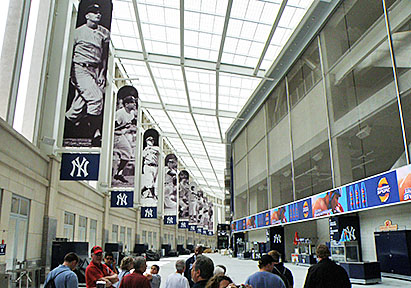 |
The New York Yankees don’t do anything halfway.
| Ballpark Stats |
 |
| Team: The New York Yankees |
| First game: April 16, 2009, a 10-2 loss to Cleveland |
| Capacity: 52,325 |
| Architect: Populous (formerly called HOK) |
| Construction: Turner Construction |
| Price: $1.5 billion, including financing costs |
| Home dugout: First base side |
| Field points: East by northeast |
| Playing surface: Kentucky bluegrass |
| Betcha didn’t know: There are an incredible 444 points of sale for concessions in the ballpark |
When you first spot their new $1.5 billion (yes, “billion” with a “b”) home, you will be shocked by its immense size. Indeed, the “footprint” of the new facility occupies 1.3 million square feet, or a full 63% more than the old House That Ruth Built — which itself is a mislabeling of the team’s previous home. Babe Ruth wouldn’t have recognized the ballpark that the Yanks moved out of in the fall of 2008. That’s because the original structure that dates back to 1923 was largely torn down following the 1973 season, forcing the Yankees to share Shea Stadium with the Mets for two seasons while a new stadium was built in the same spot in the Bronx. That’s why it always struck me as odd that journalists and many fans were so sentimental over the closing of the second version of Yankee Stadium in 2008. True — some of the foundation and outer walls were from the original facility, but what made its debut in 1976 just wasn’t quite as historic as everyone was saying in 2008.
But let’s talk about something that is historic! The brand-new ballpark, which some might justifiably refer to as Yankee Stadium III, both embraces history and makes history in ways that no other franchise could even contemplate.
First, it embraces history in a way that is unmistakable. It’s not too strong to say that you’re beaten over the head with the team’s storied past as you walk around the stadium. It’s everywhere, and you are reminded constantly that you’re in the home of the fabled New York Yankees, winners of 26 World Series. It’s not a “fun” telling of history, though. It’s a very serious, solemn telling of the Bronx Bombers’ past. This is in very, very stark contrast to the Mets’ new home just a 7.7-mile drive away. Much more on the enormously different approach of the two new NYC facilities will be in our review of Citi Field, but suffice it to say that the adjectives “solemn” and “reverent” apply only at Yankee Stadium, not Citi Field. One glance at The Great Hall (pictured above) tells you that.
That’s not to say that the new stadium in the South Bronx isn’t impressive. It certainly is … and it sure should be, seeing as how it cost a billion-and-a-half dollars. And that’s the way that it makes history, as the most expensive sports facility ever built.
Did the Yankees and their fans get their money’s worth? Well, when that many dollars are spent, expectations can be awfully darn lofty. Yes, it’s an incredible place, as we will see, but my personal opinion is that Citi Field, at $800 million, was a tremendously better value than the Yanks’ $1.5 billion.
So let’s take a look at the four categories that we always examine in our in-depth reviews: the ballpark’s location; its exterior; the architectural design on the inside and the game-day experience for the fans.
The Setting
If you liked the location of the Yankees’ old home, you’ll like the new one. If you didn’t like it, well, you won’t find the new location an improvement, because it’s directly across 161st Street from their 1923-2008 home.
This is indeed in the South Bronx. The Bronx is one of New York City’s five boroughs, and it has a reputation for being, well, dangerous. I’ve never wandered more than a few blocks away from the site of the new and old parks, so I can’t vouch for its safety or lack thereof.
I can tell you, though, that I honestly enjoy walking around the neighborhood that surrounds the stadium. Both in 2008, when I came to take a tour of the old park in its final season, and when I came to take a tour of the new place in 2009, I had several hours to kill between the tours and the games later in the day. I had a great time wandering up the hill along 161st Street going east from the ballpark, shopping in the endless souvenir stores and eating in truly authentic New York delis. And I felt absolutely safe the whole time.
 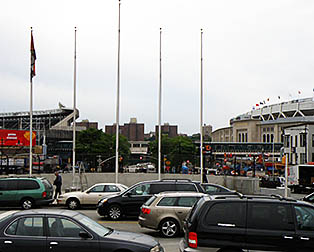 |
One oasis that warrants a pilgrimage up this hill is Lou Gehrig Plaza (above left). This garden in the median of 161st Street looks like it’s been here — and lovingly cared for — for decades. And from this somewhat elevated spot, you can look down the hill at both the new park and old (above right, with the old park on the left and the new on the right).
But it’s also noteworthy what’s on the opposite side of the Stadium. To understand the relevance of this, we must digress for a short history lesson.
The Yankees had been tenants of the Giants in the Polo Grounds from 1913 through 1922, when Colonel Jacob Ruppert decided his team (with a young phenom named George Herman Ruth) needed its own ballpark. He didn’t look far for a site, paying $600,000 for a lumberyard almost directly across the Harlem River.
And, indeed, from 1923 until the Giants moved West in 1957, the two teams did battle little more than a mile apart. In fact, the 1923, 1936, 1937, and 1951 World Series merely jumped back and forth between the two parks, as the AL Yanks slayed the NL Giants all four times.
Demolition of the Polo Grounds began in April 1964, and public high-rise housing was built in its place. There are no remnants of the old park, but it is worth walking across the Macombs Dam Bridge from Yankee Stadium to visit the site, where you will find a plaque showing where the playing field used to be. Note: you’ll have to hunt for the plaque, because if you go to the offices and ask where they are, you’ll basically receive a blank look. Also, I recommend you visit this area only in broad daylight.
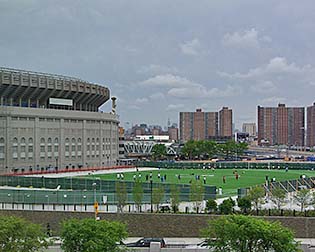 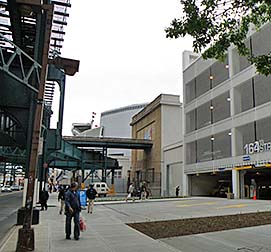 |
Technically, new Yankee Stadium was built on the sports fields in Macombs Dam Park. The loss of these fields was decried by a number of community organizers (this is New York, remember, not Chicago, so none of them were elected President of the U.S.), and the Yankees and the city are working to replace the playing fields lost to the Stadium. In fact, the surface level of the new parking garage between the old and new parks has fields on it (above left, with the old stadium still very evident on the left side of the shot), and when old Yankee Stadium is finally dismantled, the plan is to build several youth baseball fields on that exact spot, with the ten-acre park to be called Heritage Field. You have to admit that this is quite fitting.
Just as was the case with the old park, the new digs are served well by New York City’s transit system. You can take either the B or D lines from the west side of Manhattan (Yankee Stadium Station, of course, which is below ground) and the Number 4 IRT train from the East side of Manhattan (161st Street/Yankee Stadium Station, which is above ground). The latter is actually elevated over River Avenue at this point, which is just beyond the outfields of both the old and new parks. The photo above right was taken looking south on River Avenue, with a new parking garage adjacent to the new stadium’s left field on the right side of the image.
The Exterior
You’ve probably heard that the new Yankee Stadium was supposed to resemble old Yankee Stadium. While this is true for the outfield dimensions, what you might not realize is that it was the 1923 version of the ballpark, not the rebuilt 1976 facility, that was to provide the model for the new park’s architecture.
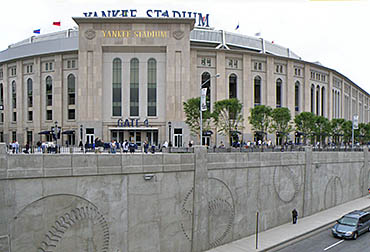 |
Nowhere is this more true than in the new park’s exterior. While the old park across the street had a little bit of a gray, dingy hue to its external walls, the new edition is a gleaming, lighter color, with a stateliness that is fit for the capitol building of a superpower.
If you look at photos of the the remarkable $2.5 million building that Colonel Ruppert built in 1923, you can’t help but notice the tall, formal walls that surrounded the entry gates. That was the look that HOK (now known as Populous) had in mind as it was designing the exterior of new Yankee Stadium. And the gleaming gold letters spelling out YANKEE STADIUM are carved into huge blocks of limestone that surround the gates and windows.
Gate 4, shown above, is the one that is behind home plate. You can also see where 161st Street is about to dip underneath the Macombs Dam Bridge extension road that connects to Jerome Avenue, and the huge baseballs imprinted into the cement on the walls.
This entry probably isn’t the one that is most heavily used, since it’s not as close to the subway stations and all of the parking structures that are a block away along River Avenue.
  |
This look also is used at two other entry points. Gate 2, which is on the extreme northern part of the stadium’s footprint along Jerome Avenue (above left) is where I saw a number of limos dropping off passengers. It’s also near the completely new parking structure called the 164th Street Garage.
Perhaps the most used entry, though, is Gate 6 (above right), which is closest to both the underground and above-ground transit stations at the intersection of River Avenue and 161st Street. This gate brings you into the Great Hall (much more on that later) and is close to the large retail store and the Hard Rock Cafe that is actually inside the stadium. Note that unlike Gates 2 and 4, there is no glass in the openings above the gates here. That’s because the immense Great Hall on the other side isn’t enclosed.
Gate 8, which is the main access to the outfield bleachers, is along River Avenue. It’s not as glitzy as the other three main entryways, but it doesn’t need to be, because the view of a tall, stately entry would be obscured somewhat by the train tracks that run over top of the street here. There is one special touch along the exterior of the stadium at this point, though. A series of color panels well above eye level show photos of current Yankee players.
 |
Finally, Babe Ruth Plaza (above) is on the first-base side of the stadium. It’s a little lower than the walkway that hugs the exterior of the park, putting it at street level. This is probably a likely place for fans to be dropped off from cars.
The Design
When you spend over a billion dollars building a stadium, the architects are quite busy creating all of the aspects of the design.
Without a doubt, Populous put some of the best and brightest sports-facility architects to work designing this massive facility. In fact, so protective were the Yankees of the design specifics of this park that they required Populous to separate this design team from the one working on the Mets’ Citi Field by putting them on different floors on opposite sides of their building!
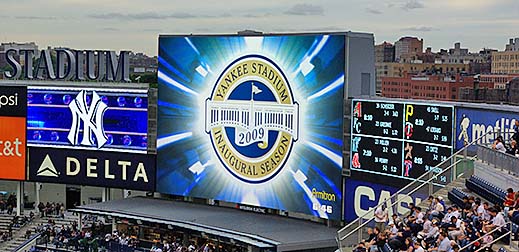 |
I have no doubt that the main message from the Yankees to the architects was, “Make this a living museum for the Yankees’ great accomplishments.” I don’t think anyone who attends a game at the new ballpark would dispute that the designers did this extremely well. From top to bottom and from outside to inside, this is a building that only the Yankees could occupy, because it was constructed to be a monument to them.
In fact, I’m not the only observer who has noted that, if anything, the place feels as much like a museum as a ballpark. It has the grandeur of the Metropolitan Museum of Art or the Smithsonian Natural History Museum, to the point where it almost feels more like a monument than a place where a child’s game is played.
When I visited the Yankees Museum inside the ballpark as part of the guided tour I attended with my family, I was a little surprised that it wasn’t bigger. After all, the team museums for the Reds and the Royals are both tremendously larger, and you certainly couldn’t make the case that those franchises have more “history” to tout than the Bronx Bombers. But then you remember that the whole stadium acts as a museum for the Yankees, and it all makes more sense.
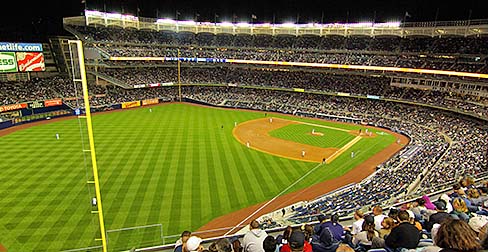 |
So let’s examine the stadium’s design, feature for feature, starting with the seating bowl. Keep in mind that the original Yankee Stadium (the one that opened in 1923) provided the template for the design of the new park. That structure was the first sports facility to (a) carry the permanent name of “stadium” (everything was a “field” or “park” up until then) and (b) it was the first to have three seating decks.
The new edition of the stadium also has three seating levels — or five, depending on how you count them. However, there’s a little more to it than that. The lowest section is referred to as the Legends/Field level, and the seating sections here either have two digits or are in the one-hundreds. The separation of these two sections is quite pronounced, as the ultra-expensive seats have two digits, and are quite a thing to behold (below left). Yes, these are the padded seats you’ve read so much about. A close up of one of these rows is on the right side below. Note the enormous, 40-inch legroom and the real-wood arm rests. One assumes that the cup holders are in the arm rests because no one would be able to reach their drink if the holders were attached to the backs of the row in front of them.
By the way, the front row of the Legends section is much closer to the action than in the old park. Through 2008, the backstop was about 72 feet from home plate. Now it is only 52 feet.
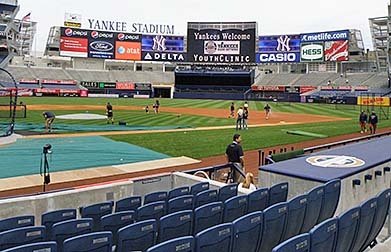 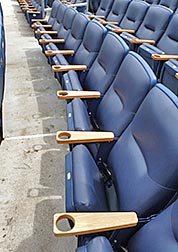 |
The Main Level is made up of seats numbered in the two-hundreds. More or less, this level circles the entire stadium, and includes the bleachers. Most of the bleachers provide a good view, not unlike the bleachers at old Yankee Stadium. However, as you get closer to center field, you see a big problem that the old place didn’t have: severely obstructed-view seats (below left). This is the result of the Bleachers Cafe being located over the batter’s eye in dead center.
The party suites and luxury boxes (there are a whopping 56 of them, compared to only 19 in the old stadium) comprise their own level, which the team calls the Luxury/Party/Club level. The party suites are clustered near the right-field foul pole, while the huge Audi Yankees Club is down the third-base line.
The topmost level contains Terrace boxes, which have section numbers in the three hundreds, and Grandstand seats, which have numbers in the four hundreds. There is a single concourse for both of these areas, and most of the way around, that concourse is “open” to the field. That’s because the Terrace seats are all below this concourse, while the Grandstand seats are physically separate, hovering above the concourse — much the same way that the upper decks are arranged at Citizens Bank Park in Philadelphia and Busch Stadium in St. Louis.
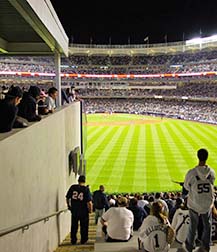 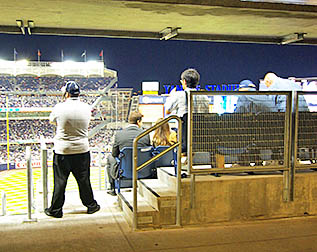 |
Oddly, though, this upper concourse isn’t completely open to the field. That’s because a number of the Terrace sections have extra rows, which block the view of the field from the concourse (above right).
And I have to point out one aspect of the Grandstand level that is troubling to me. I know the famous frieze is an iconic element of Yankee Stadium, going back decades. The original facility had the frieze (which was made of copper) around the roof in the infield. When the stadium was rebuilt in the 1970s, the frieze for some reason was in the outfield. I’m thankful that the new park has this feature back in the infield … however, it is so large (it weighs about 300 tons!) it is distracting when you’re sitting in the upper rows (below left).
  |
Helping you navigate to and from your seats are, of course, the concourses. This might be the single biggest improvement over the old park, because the concourses beneath the stands at old Yankee Stadium were clearly too narrow. The one on the upper deck, in fact, was criminally cramped. At the new park, the average width of the concourses is 32 feet, almost double the size of the average concourse at the old place. The one shown on the right side above is on the Main seating level.
The two most noteworthy aspects of the architecture that don’t have anything to do with seating are Monument Park and The Great Hall.
Monument Park at the old ballpark was perhaps its most-loved feature. Fans would line up for hours to file past the plaques and memorials there, and the waits were clearly worth it. The waits are still quite long to see the new stadium’s Monument Park (below), and all of the old favorite features are there — the 9/11 memorial, the centerpiece monuments to Ruth, Huggins and Gehrig, all of the retired numbers — but it has a different feel now. While it’s still covered in netting, it’s now in dead center field instead of left field — and the arrangement of the space just seems a little too perfect to me. It’s too symmetrical and the landscaping is too finely manicured. There was a special appeal about the old Monument Park where you felt like areas were added as the number of plaques and retired numbers grew over the years. At the new park, everything is just too meticulously arranged. It’s a little too clinical and not nearly organic enough for me.
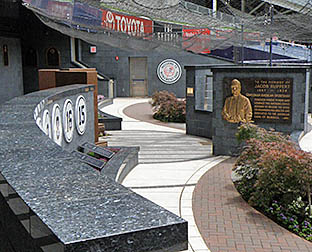  |
The massive Great Hall, for which there is no comparable area in any other ballpark, is overwhelming. This 31,000-square-foot concourse is the first part of the facility that you step into when you enter through Gate 2. At the west (home plate) end is an area where you can purchase artifacts from old Yankee Stadium and an escalator that takes you to Tommy Bahama’s Bar. At the east end (below) is one of the four walk-in souvenir stores and the elevators to the team museum and the NYY Steak restaurant. There’s also a high-res video screen that is 24 feet by 36 feet — bigger than the main screens in the outfields at many other big-league parks. Running along the inside wall is a five-foot-tall ribbon board that is an incredible 383 feet long. Yes, there’s no shortage of ways for the Yanks to show you Great Ads while you’re in the Great Hall.
While it’s true that this “Hall” is covered, it’s interesting that its wide-open windows mean that it isn’t enclosed. Consequently, there’s no heating and no AC there — and when it’s raining, the wind blows the precipitation into the area. I found this out first hand when waiting out a five-hour rain delay there.
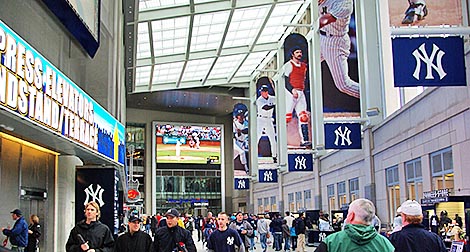 |
The fact that this area is unheated and uncooled brings us to a much-touted aspect of new Yankee Stadium — the “green” aspects of the park. Indeed, the Yanks list the fact that The Great Hall isn’t air conditioned as one of the “green initiatives” that were undertaken in the design of this park. In fact, they trumpet the fact that the power saved by there being no AC is equivalent to (quoting the team’s website) “10,000 New York City apartments shutting off their air conditioning for a summer day.”
The more-efficient plumbing fixtures in the restrooms are projected to save over 3 million gallons of water per year, which represents about 22 percent of the total water consumed at the ballpark. Also, all beverage cups are made of biodegradable materials instead of plastic, and each lighting fixture atop the ballpark consumes about 300 fewer watts than the previous lights. Further, sophisticated computer systems operate the lighting and heating/cooling in the park, thereby reducing power consumption considerably.
These green initiatives aren’t quite the extreme lengths taken at Washington, DC’s new park (which was the first sports stadium to be awarded LEED certification), but they are admirable.
Finally, it seems to me that there are a couple of areas within the confines of the ballpark that aren’t really needed — or, at best, aren’t yet utilized to their fullest potential. They remind me of constructing a house with far more bedrooms than you need for your family, guests, a den … and all of your pets! One such area is just inside Gate 2 on the northern side of the facility (below left). Here there is a wide, high-ceilinged lobby-like area that isn’t really needed — although it is very attractive. Since there was already a Great Hall in the park, maybe this was meant to be the Not Quite As Great Hall.
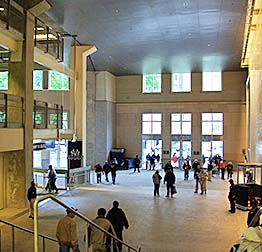 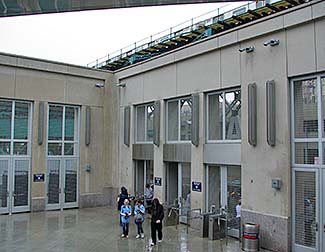 |
Another under-utilized area is just inside Gate 8 (above right), which is the one closest to the bleachers. Unlike the aforementioned “Halls,” this large, square area isn’t covered. Perhaps in the future there will be points of sale added here, or bands playing as fans arrive.
I guess it doesn’t hurt to have room to grow.